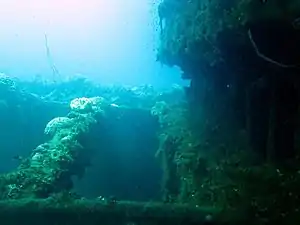Fujikawa Maru
Fujikawa Maru was a cargo ship originally built in 1938 for the Toyo Kaiun Kisen Kaisha and was requisitioned by the Imperial Japanese Navy during World War II for use as an armed aircraft transport or ferry. She was sunk in Truk Lagoon in 1944 during Operation Hailstone and is now a leading wreck diving site for scuba divers.
 Fujikawa Maru The Fujikawa Maru wreck | |
| History | |
|---|---|
| Name: | Fujikawa Maru |
| Owner: | Toyo Kaiun K.K., Tokyo |
| Operator: | Imperial Japanese Navy |
| Builder: | Mitsubishi Zosensho, Nagasaki |
| Yard number: | 45067 |
| Launched: | 1938 |
| Homeport: | Tokyo |
| Fate: | Sunk by torpedo attack 17 February 1944 |
| General characteristics | |
| Type: | Transport |
| Displacement: | 6,938 long tons (7,049 t) |
| Length: | 437.4 ft (133.3 m) |
| Beam: | 58.5 ft (17.8 m) |
| Draught: | 26 ft (7.9 m) |
| Speed: | 13.5 knots (25.0 km/h) |
| Range: | 5,000 nmi (9,300 km; 5,800 mi) at 13.5 knots (25.0 km/h; 15.5 mph) |
| Complement: | 162 |
| Service record | |
| Operations: | Battle of Midway, Operation Hailstone |
History
Fujikawa Maru was requisitioned in 1940 by the Imperial Japanese Navy, and was based in Indo-China under the command of the 11th Fleet. She saw service in the Battle of Midway as part of AiRon 7. On 12 September 1943 she was hit by a torpedo fired by the United States submarine Permit, and returned to Japan for repairs. Subsequently on 5 December 1943 she was hit by torpedo bombers from the aircraft carrier USS Yorktown suffering minor damage. From thence she was taken to Truk Lagoon (now Chuuk Lagoon) to undergo repairs.
On 17–18 February 1944 she was hit repeatedly by US bombers and torpedo bombers as part of Operation Hailstone, before she finally sank on 18 February at approximately 7:15am.
Dive site
Fujikawa Maru is regarded as the best scuba diving site in Chuuk Lagoon by both of the principal authors who have undertaken comprehensive surveys of the lagoon, Dan E. Bailey[1] and Klaus Lindemann.
Amongst the more striking features on the wreck are four disassembled Mitsubishi fighter aircraft in one of the forward holds. Three of the aircraft are A6M Zeros and the fourth is an A5M Claude, the sole known survivor of the type. The vessel also boasts a 6-inch (152 mm) bow gun, left over from the Sino-Japanese war and retrofitted.
The Times named it as one of the top 10 wreck dives in the world,[2] and Aquaviews ranked it as the fourth best wreck dive in the world.[3]
Footnotes
- At page 288 of his book, Mr Bailey indicated "The wreck has long been the best known and associated with the best of the attractions that Truk has to offer."
- The Times (3 March 2007). "World's best wreck diving". Retrieved 6 February 2010.
- "World's Top 10 Wreck Dives (Part-II)". 5 July 2009. Archived from the original on 9 March 2011. Retrieved 14 February 2011.
References
- Bailey, Dan E. (1992). World War II: Wrecks of the Kwajalein and Truk Lagoons. North Valley Diver Publications. ISBN 0-911615-05-9.